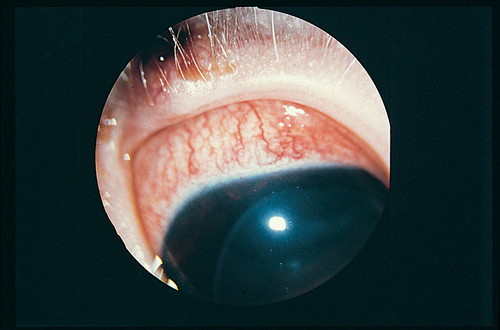Difference between revisions of "Small Animal Emergency and Critical Care Medicine Q&A 13"
(Created page with "[[Image:|centre|500px]] <br /> '''A four-year-old Sealyham Terrier presented with acute onset unilateral (right) ocular pain. There was marked blepharospasm and excessive lacri...") |
|||
| (3 intermediate revisions by 2 users not shown) | |||
| Line 1: | Line 1: | ||
| − | [[Image:|centre|500px]] | + | {{Template:Manson |
| + | |book = Small Animal Emergency and Critical Care Medicine Q&A}} | ||
| + | |||
| + | |||
| + | [[Image:ECC 13.jpg|centre|500px]] | ||
<br /> | <br /> | ||
| − | '''A four-year-old Sealyham Terrier presented with acute onset unilateral (right) ocular pain. There was marked blepharospasm and excessive lacrimation. Initial examination revealed episcleral congestion and mild corneal edema. The pupil was semidilated and | + | '''A four-year-old Sealyham Terrier presented with acute onset unilateral (right) ocular pain. There was marked blepharospasm and excessive lacrimation. Initial examination revealed episcleral congestion and mild corneal edema. The pupil was semidilated and non-responsive to light. The iris was bowed posteriorly but the fundus appeared normal, although the dog was blind on this side.''' |
| − | non-responsive to light. The iris was bowed posteriorly but the fundus appeared normal, although the dog was blind on this side.''' | ||
<br /> | <br /> | ||
| Line 12: | Line 15: | ||
|a1= | |a1= | ||
The illuminated lateral equator of the displaced lens can be seen indicating the position of the lens in the anterior chamber. | The illuminated lateral equator of the displaced lens can be seen indicating the position of the lens in the anterior chamber. | ||
| − | |l1= | + | |l1=Lens Luxation |
|q2=What is your diagnosis? | |q2=What is your diagnosis? | ||
|a2= | |a2= | ||
Secondary glaucoma due to anterior luxation of the lens. | Secondary glaucoma due to anterior luxation of the lens. | ||
| − | |l2= | + | |l2=Lens Luxation |
|q3=Why is the dog blind in this eye? | |q3=Why is the dog blind in this eye? | ||
|a3= | |a3= | ||
Because of the optic neuropraxia. | Because of the optic neuropraxia. | ||
| − | |l3= | + | |l3=Lens Luxation#Clinical Signs |
|q4=What treatment would you prescribe? | |q4=What treatment would you prescribe? | ||
|a4= | |a4= | ||
| Line 28: | Line 31: | ||
The condition is inherited recessively and, although bilateral, there may be considerable delay between the first and second eye involvements. | The condition is inherited recessively and, although bilateral, there may be considerable delay between the first and second eye involvements. | ||
| − | |l4= | + | |l4=Lens Luxation#Treatment |
</FlashCard> | </FlashCard> | ||
Latest revision as of 17:40, 30 September 2011
| This question was provided by Manson Publishing as part of the OVAL Project. See more Small Animal Emergency and Critical Care Medicine Q&A. |
A four-year-old Sealyham Terrier presented with acute onset unilateral (right) ocular pain. There was marked blepharospasm and excessive lacrimation. Initial examination revealed episcleral congestion and mild corneal edema. The pupil was semidilated and non-responsive to light. The iris was bowed posteriorly but the fundus appeared normal, although the dog was blind on this side.
| Question | Answer | Article | |
| Describe the pathology seen in the eye. | The illuminated lateral equator of the displaced lens can be seen indicating the position of the lens in the anterior chamber. |
Link to Article | |
| What is your diagnosis? | Secondary glaucoma due to anterior luxation of the lens. |
Link to Article | |
| Why is the dog blind in this eye? | Because of the optic neuropraxia. |
Link to Article | |
| What treatment would you prescribe? | Emergency therapy necessitates the reduction of the intraocular pressure to a physiological value. This can be achieved initially by using a hyperosmotic agent, providing the blood aqueous barrier is intact, but cure requires the emergency removal of the lens. The condition is inherited recessively and, although bilateral, there may be considerable delay between the first and second eye involvements. |
Link to Article | |
